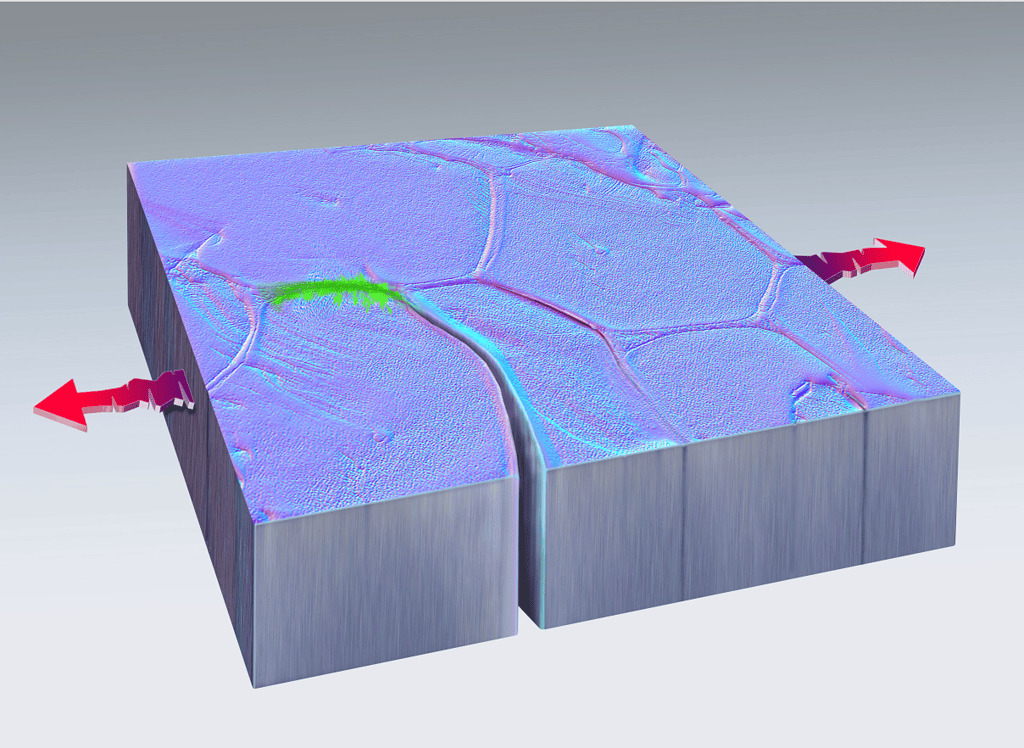
You might think that self-healing metal is something out of science fiction, perhaps like the shape-shifting android in Terminator 2: Judgment Day. But guess what? It’s now a scientific reality.
In an exciting new study, scientists have successfully demonstrated self-healing properties in certain metals, paving the way for innovative applications in the near future. Imagine bridges, vehicles, or any mechanical parts subjected to wear and tear that can ‘fix’ themselves.
A happy accident
Metal fatigue, a phenomenon where microscopic cracks develop in metals subjected to repeated stress, has been a long-standing challenge in engineering. This damage tends to worsen over time and can lead to disastrous consequences in critical areas like aviation and infrastructure. But recent experiments conducted at the Sandia National Laboratories in New Mexico may forever change how engineers tackle this kind of defect.
Researchers led by Brad Boyce were studying metal fatigue in platinum when they serendipitously noticed that cracks in the material were repaired without their intervention. Using tiny metal pieces made of pure platinum and copper, the researchers pulled the material from each side at an astonishing rate of 200 times per second. As expected, cracks began to form and spread. However, around 40 minutes into the experiment, the metal pieces spontaneously fused back together.
“This was absolutely stunning to watch first-hand,” said Boyce. “What we have confirmed is that metals have their own intrinsic, natural ability to heal themselves, at least in the case of fatigue damage at the nanoscale.”
This process is known as cold welding. Everything occurs at the nanoscale, meaning it’s not visible to the human eye. Cold welding occurs when two pieces of metal, whose surfaces must be smooth and clean, come together, forming atomic bonds that facilitate self-repair. Essentially, it allows you to weld metals without heat. But now scientists have shown that this process can happen spontaneously without careful preparation, which opens up a world of new applications.
The metal pieces used in the experiments were approximately 40 nanometers thick and a few micrometers wide. While the healing was observed in platinum and copper, simulations suggest that this phenomenon could occur in other metals as well. The possibility of applying this breakthrough to materials tailored for specific purposes has scientists buzzing with excitement.

For instance, engineers could design bridges or sensitive infrastructure to specifically facilitate spontaneous cold welding, greatly enhancing their service life. Moreover, this newfound understanding may shed light on fatigue failure in existing structures, potentially enhancing our ability to interpret and predict such issues.
In the past, scientists have dabbled with self-healing materials, mainly focusing on plastics. However, study co-author Michael Demkowicz, a materials science and engineering professor at Texas A&M University, foresaw the potential for self-healing in metals a decade ago. And now, with this successful research, his predictions have come true.
“My hope is that this finding will encourage materials researchers to consider that, under the right circumstances, materials can do things we never expected,” said Demkowicz.
While it’s too soon to see tangible applications, the researchers believe that within the next decade, we might witness real-world use of self-healing metals. Although this is not exactly akin to the shape-shifting androids we see in science fiction, it’s a significant step towards materials that can heal themselves, much like organic tissues such as human skin.
As an important caveat, the experiments were conducted in a vacuum using an electron microscope, scientists are keen to explore if the process also occurs in a normal air atmosphere. Regardless, the findings have profound implications for metal fatigue in space vehicles and subsurface cracks that aren’t exposed to the atmosphere.
The future of self-healing metals holds immense promise for a wide range of industries and applications. As scientists delve deeper into this fascinating field, we can look forward to a world where materials can repair themselves, making machines and structures more robust and reliable.
The findings appeared in the journal Nature.









